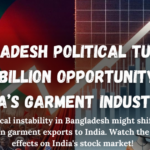Political turmoil in Bangladesh, a leading player in the global garment industry, could significantly impact India’s garment sector. Bangladesh is currently the second-largest garment exporter globally, after China, and any instability in its production capabilities could result in a shift in global orders to other countries, with India being a prime beneficiary due to its established garment manufacturing base.
Potential Percentage Boost in Export Orders
India’s garment industry could potentially see an increase in export orders due to two key factors:
Diversion of Orders: Global retailers and buyers might divert orders from Bangladesh to mitigate risks caused by political unrest. Based on historical precedents (e.g., the Rana Plaza collapse in 2013, which temporarily diverted garment orders to India and Vietnam), a boost of 15-20% in export orders over the next 18 months is a reasonable estimate.
Capacity Utilization: India’s garment sector currently operates with substantial underutilized capacity. This excess capacity can be quickly leveraged to meet rising demand, which supports the estimate of a 15-20% boost.
Increase in Value Terms
India’s garment exports were valued at approximately $16 billion annually in recent years. A 15-20% increase over 18 months could result in an additional $2.4-3.2 billion in export value annually. This calculation assumes no drastic price drops or rises, but considers steady global demand.
Impact on Indian Stock Market
Apparel and Textile Stocks: Companies involved in garment manufacturing and exports—such as Page Industries, Arvind Ltd, Raymond Ltd, and Welspun India—could experience a surge in demand and revenue, boosting their stock prices. Investors may anticipate these positive trends, leading to a short- to medium-term rally in textile-related stocks.
Rupee Strengthening: The increase in garment exports could lead to a higher inflow of foreign exchange, which might strengthen the Indian Rupee. This could have broader implications for sectors sensitive to currency fluctuations, such as IT and pharma.
Sectoral Rotation: If investors expect sustained demand in the garment sector due to prolonged political turmoil in Bangladesh, there could be a rotation of capital into textile stocks, especially mid-cap and small-cap companies in the sector. This could lead to an overall positive sentiment for the broader market as well, particularly for export-oriented sectors.












